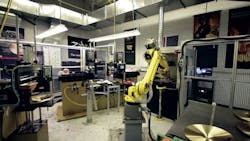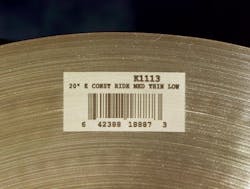Avedis Zildjian Company recently installed two LNA Laser marking systems in the company's Norwell, MA factory. Zildjian is the world's oldest cymbal manufacturer and one of the oldest family-owned businesses in the United States. Their customers form a who's-who list of drummers (FIGURE 1), from jazz legends Gene Krupa and Buddy Rich to rock pioneers such as Ringo Starr of The Beatles, Charlie Watts of The Rolling Stones, and Keith Moon of The Who.
History
Avedis Zildjian I was an Armenian alchemist in the city of Constantinople. While trying to make gold from base metals, he came upon an alloy of tin, copper, and trace amounts of silver that exhibited a distinctive sound and was resilient enough not to shatter. Zildjian used his new discovery to create his first cymbals in 1618. The Ottoman Sultan was so impressed with the clarity that he invited the alchemist to live at the Topkapi Palace, where Zildjian made cymbals for the marching bands of the Janissaries (an elite infantry unit), which would strike fear in their adversaries with the crash of Zildjian cymbals. Avedis was held in such high regard, the Sultan gave him the name Zildjian, which means "son of a cymbal maker" in Armenian. In 1623, Zildjian received the Sultan's permission to leave his charge to set up his own business, which he located in Psamatia, a suburb of Constantinople.
In 1929, one month before the Great Depression, Avedis III received the secret Zildjian cymbal formula from his uncle and began making cymbals in Quincy, MA. Subsequently, he moved the family business to their current location in Norwell. Avedis III was an innovator, being the first to develop cymbals for drum sets. He also gave these new cymbals names that are still used today—crash, splash, ride, and hi-hat.
The business is now 392 years old, having been passed down through the Zildjian family for 15 generations. Interestingly, the manufacturing process has remained secret, only being passed down to the heirs. Currently, Avedis III's granddaughters Craigie and Debbie run the business in America.
Cymbal formula
To make cymbals, they start with castings made with a secret blend of approximately 80% copper, 20% tin, and trace amounts of silver—referred to as "Bell Bronze." This time-tested ratio of tin to copper produces a richer, more sustaining sound from the cymbal. Another alloy consisting of only 8% tin to 92% copper produces a brighter sound with more high frequencies. "The secret is in how the alloy is produced," according to Paul Struble, VP of operations. "In fact, the director of research and development isn't even allowed in the foundry."
After the castings have been made, they are sorted by weight. A moving tray takes the casting to a rotary oven at 1500˚F, which softens it and allows for stress release. Workers place the castings in a rolling mill, where they are squeezed between two large metal cylinders—like rolling out a pie crust. The castings become thinner, flatter, and larger in diameter. Depending on the cymbal type, the castings can go through a heating and rolling cycle up to 12 times. The repeated heating and cross rolling creates a dense interlocking weave in the granular structure of the alloy to make them strong enough for a real beating. The interlocking weave helps transmit the sound waves more rapidly across the cymbal.
After the cymbal has been tempered and pressed to its final shape, they place it on a spindle, where circular cutters shear the edges to a set diameter. The diameters can range anywhere from a 6in. splash cymbal up to a 24in. ride cymbal. Next, the cymbal is pounded with a hydraulic hammer. These impressions enrich the cymbal's sound by changing the path of the sound waves. A cymbal craftsman places the cymbal on a lathe, where the outer layer is removed and tonal grooves are carved into the cymbal. The depth and position of the grooves is dependent on the cymbal type. A cymbal craftsman must complete a five-year apprenticeship to acquire the skills necessary for this important step.
An edging machine rounds the edges of the cymbals. The cymbals are then sent to quality control where a sound technician tests each cymbal for a range of tonal qualities. Lastly, a laser is used to engrave the trademark with a unique serial number, after which they are ready for shipping anywhere in the world.
To make a cymbal is very labor-intensive and requires skilled craftsmen. "We are constantly looking for ways to improve our process and our quality. In the past, it would take 22 days from start to finish to manufacture a 16in. cymbal, whereas today, we can do it in about eight hours," Struble adds.
Keeping an open ear has made Zildjian the market leader. They work closely with musicians and produce custom products for many well-known drummers, such as Max Weinberg of Bruce Springsteen's E Street Band and Carter Beauford of the Dave Matthews Band. "When we develop a prototype using a new design or new alloy, we invite artists to give us their feedback," Struble says.
Fiber lasers improve marking capabilities
Zildjian was the first music company in the US to receive ISO 9001 certification. Part of that process required traceability of the products. "Prior to ISO certification, we would use roll forming to emboss our logo onto each cymbal, but we had no way of creating permanent serial numbers," Struble says. "In the early '90s, we turned to lamp-pumped, Nd:YAG lasers for marking, as it allowed us to remove a mechanical step by engraving our logo with a laser and, most importantly, allowing us to permanently mark each cymbal with a unique serial number."
There was an added benefit for drummers. Musicians may have several thousands of dollars invested in cymbals. Before serialization, insurance companies wouldn't issue policies, as they had no way of authenticating the model of the cymbal. "Subsequently, we had a robot integrated into the production process," Struble explains (FIGURE 2). "Now, one operator can use two laser marking systems simultaneously."
These lasers, now over 20 years old, were prone to frequent failures in addition to the downtime for routine flash lamp changes and maintenance. The laser marking is the last step prior to shipping. "It was becoming a real problem to meet delivery schedules. We decided we needed to upgrade the laser marking process. After a little research, it appeared that a fiber laser-based system would offer the reliability and low maintenance we needed. About the same time, we were referred to LNA Laser (Pawtucket, RI)," Struble explains.
"We took a number of cymbals and visited LNA Laser's application lab," Struble adds. "Literally within one hour, they uploaded our graphics, optimized the laser marking parameters, and were producing laser marks with exceptional quality. With the LNA software, we could do one pass, two passes, fill in void areas—we could do anything and everything. We purchased two complete, turnkey fiber laser marking systems from LNA. The installation and integration with our robotic automation was really fast and easy. We were back in production after only four hours. LNA's software was fully customizable for our needs."
A simple user interface was created to limit operator time and potential for error. The interface allows the operator to scan a barcode that contains a lot number, job number, and serial number (FIGURE 3), and load the appropriate marking file template from a central database. Additionally, the LNA software automatically increments the serial number after each marking cycle.
"It was an interesting project for us, where we were able to integrate our laser marking platform into Zildjian's existing production without the need for sometimes-costly new enclosures or hardware," says Daniel Gold, president of LNA Laser. "Our fiber laser systems provide Zildjian with greatly improved mark quality, process control, traceability, productivity, and reliability over their previous-generation laser markers."
"We are looking to implement the 2D data matrix capability of the LNA Laser marker," Struble says. "Most drummers will peel off the barcode sticker, as they worry it may impact the sound. The data matrix can be made incredibly small and provide more information than a standard barcode, and have no impact on the tonal quality of the cymbal. This will benefit us in tracking cymbals and for our dealers for inventory control and accurate pricing at the cash register."
Isn't it great to see the oldest US family-owned company embrace the latest in technology, from lasers to automation to laser marking techniques? Rock on, Zildjian!
To see a video of LNA laser systems in action at the Zildjian factory, please visit www.lnalaser.com/zildjian.
Rick Slagle | Managing Partner, Technical Solutions Marketing
Rick Slagle is a managing partner at Technical Solutions Marketing (Maynard, MA).


